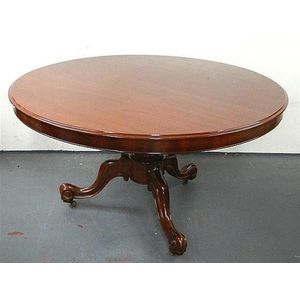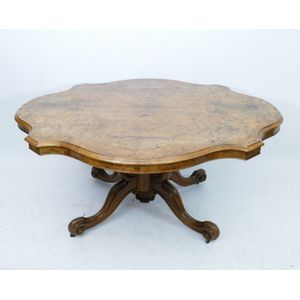Victorian Burr Walnut Drawing Room Table
An outstanding Victorian burr walnut drawing room table, with a scalloped edge and a central carved column on four carved splayed legs. 73 cm high, 146 cm wide, 108 cm deep
You must be a subscriber, and be logged in to view price and dealer details.
Subscribe Now to view actual auction price for this item
When you subscribe, you have the option of setting the currency in which to display prices to $Au, $US, $NZ or Stg.
This item has been sold, and the description, image and price are for reference purposes only.
- Scallop / Shell Motif - The shell motif has been used in furniture and decorative arts for centuries. In ancient Greece and Rome, shells were often used as decorative elements on furniture and in mosaics. The scallop or cockleshell are the most commonly used. During the Renaissance, the shell motif became popular in furniture and architecture, as the ornate decoration was seen as a symbol of wealth and luxury. In the 18th century, the Rococo style of furniture and decorative arts featured an abundance of shell motifs, and it was used by Thomas Chippendale and as a feature on Queen Anne style cabriole legs. In the 19th century, the shell motif was incorporated into Victorian furniture and decorative items, and often a representation of the the conch shell was inlaid into furniture.
- Victorian Period - The Victorian period of furniture and decorative arts design covers the reign of Queen Victoria from 1837 to 1901. There was not one dominant style of furniture in the Victorian period. Designers used and modified many historical styles such as Gothic, Tudor, Elizabethan, English Rococo, Neoclassical and others, although use of some styles, such as English Rococo and Gothic tended to dominate the furniture manufacture of the period.
The Victorian period was preceded by the Regency and William IV periods, and followed by the Edwardian period, named for Edward VII (1841 ? 1910) who was King of the United Kingdom and the British Dominions and Emperor of India for the brief period from 1901 until his death in 1910. - Burr - Burr (or in the USA, burl) is the timber from the knotted roots or deformed branch of the tree, which when cut, displays the small circular knots in various gradations of colour. It is always cut into a decorative veneer, most commonly seen as burr walnut on 19th century furniture.
- Column - An architectural feature sometimes used for decorative effect and sometimes as part of the supporting construction. Columns should generally taper slightly towards the top. They may be plain or decorated with carving, fluting or reeding. Columns may be fully rounded or, more commonly, half-rounded and attached with glue, screws or pins to the outer stiles of doors, or the facing uprights on cabinets and bureaux.
Visually similar items

Round Australian cedar single pedestal dining table
Sold by
in
for
You can display prices in $Au, $US, $NZ or Stg.

A Victorian mahogany tilt top dining table and four upholstered balloon back chairs with birdcage base table 70 x 135 x 103 cm
Sold by
in
for
You can display prices in $Au, $US, $NZ or Stg.

Antique mid 19th century French mahogany marble topped centre table, approx 73.5 cm high, 98 cm deep
Sold by
in
for
You can display prices in $Au, $US, $NZ or Stg.

A Victorian burr walnut loo table, the oval serpentine burr walnut top with quartered veneer raised on a quadrapod cathedral type base, brass casters. 142 cm x 114 cm x 74.5 cm
Sold by
in
for
You can display prices in $Au, $US, $NZ or Stg.
